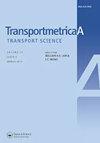半自动卡车队列中驾驶员和卡车的联合作业规划
IF 3.1
2区 工程技术
Q2 TRANSPORTATION
引用次数: 0
摘要
随着自动驾驶技术的日益成熟,卡车在高速公路上行驶的一种未来的、有前途的卡车行驶方式——半自动卡车队列行驶受到了广泛的关注。在半自动队列模式下,队列中每辆卡车不需要一名人工驾驶,领头卡车只需一名人工驾驶,所有跟随的卡车都可以通过自动驾驶和无线通信技术进行控制。因此,除了节约能源之外,这种技术还可以通过使用更少的司机来满足相同的需求,从而帮助降低劳动力成本。与传统的卡车队列驾驶相比,半自动卡车队列驾驶下驾驶员的日程安排可能与卡车不完全相同,这一点在最近的研究中经常被忽视。因此,在本文中,我们首次尝试建立一个数学建模框架来优化司机和卡车的相互依赖的操作计划。值得一提的是,卡车车队配备了半自动队列功能和时间窗口。具体而言,作业计划将决定需要派遣的司机数量,以及司机和卡车的行驶路线和时间安排,其目标是在满足所有交付需求的同时最小化总运营成本,包括司机的固定调度成本、道路人工成本和能源消耗成本。为了及时解决大规模问题,提出了一种定制的拉格朗日松弛方法来求解模型。通过数值实验验证了所提建模框架的性能,并验证了所提求解算法的可行性和有效性。本文章由计算机程序翻译,如有差异,请以英文原文为准。
Joint operation planning of drivers and trucks for semi-autonomous truck platooning
Semi-autonomous truck platooning, a futuristic and promising traveling mode of trucks on highways, has received extensive attention as autonomous driving gains more maturity. Under the semi-autonomous platooning mode, rather than requiring a human driver for each truck in the platoon, only one human driver is needed for the leading truck, and all following trucks can be controlled by autonomous driving and wireless communication technology. Therefore, in addition to saving energy, such a technology can help reduce labor costs by using fewer drivers to fulfill the same demand. Compared to traditional truck platooning, the schedules of drivers under semi-autonomous truck platooning may not be exactly the same as trucks, which are usually neglected in recent studies. Therefore, in this paper, we make the first attempt to develop a mathematical modeling framework to optimise the operation plan of drivers and trucks interdependently. To be mentioned, the truck fleet is equipped with the semi-autonomous platooning function and time windows. Specifically, the operation plan will dictate the number of drivers to be dispatched, and traveling routes and time schedules of drivers and trucks interdependently with the objective to minimise the total operation cost, including drivers' fixed dispatch cost, on-road labor cost, and energy consumption cost while fulfilling all delivery demands. To tackle the large-scale problem in a timely manner, a tailored Lagrangian Relaxation approach is proposed to solve the model. Numerical experiments are conducted to demonstrate the performance of the proposed modeling framework and validate the feasibility and efficiency of the proposed solution algorithm.
求助全文
通过发布文献求助,成功后即可免费获取论文全文。
去求助
来源期刊

Transportmetrica A-Transport Science
TRANSPORTATION SCIENCE & TECHNOLOGY-
CiteScore
8.10
自引率
12.10%
发文量
55
期刊介绍:
Transportmetrica A provides a forum for original discourse in transport science. The international journal''s focus is on the scientific approach to transport research methodology and empirical analysis of moving people and goods. Papers related to all aspects of transportation are welcome. A rigorous peer review that involves editor screening and anonymous refereeing for submitted articles facilitates quality output.
 求助内容:
求助内容: 应助结果提醒方式:
应助结果提醒方式:


